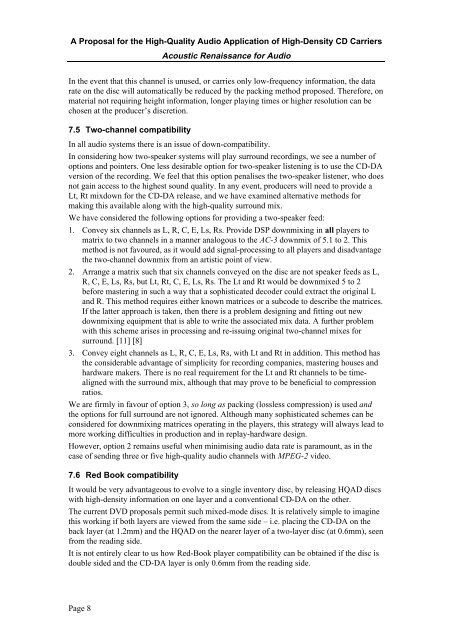A Proposal for the High-Quality Audio Application of High ... - Meridian
A Proposal for the High-Quality Audio Application of High ... - Meridian
A Proposal for the High-Quality Audio Application of High ... - Meridian
Create successful ePaper yourself
Turn your PDF publications into a flip-book with our unique Google optimized e-Paper software.
A <strong>Proposal</strong> <strong>for</strong> <strong>the</strong> <strong>High</strong>-<strong>Quality</strong> <strong>Audio</strong> <strong>Application</strong> <strong>of</strong> <strong>High</strong>-Density CD Carriers<br />
Page 8<br />
Acoustic Renaissance <strong>for</strong> <strong>Audio</strong><br />
In <strong>the</strong> event that this channel is unused, or carries only low-frequency in<strong>for</strong>mation, <strong>the</strong> data<br />
rate on <strong>the</strong> disc will automatically be reduced by <strong>the</strong> packing method proposed. There<strong>for</strong>e, on<br />
material not requiring height in<strong>for</strong>mation, longer playing times or higher resolution can be<br />
chosen at <strong>the</strong> producer’s discretion.<br />
7.5 Two-channel compatibility<br />
In all audio systems <strong>the</strong>re is an issue <strong>of</strong> down-compatibility.<br />
In considering how two-speaker systems will play surround recordings, we see a number <strong>of</strong><br />
options and pointers. One less desirable option <strong>for</strong> two-speaker listening is to use <strong>the</strong> CD-DA<br />
version <strong>of</strong> <strong>the</strong> recording. We feel that this option penalises <strong>the</strong> two-speaker listener, who does<br />
not gain access to <strong>the</strong> highest sound quality. In any event, producers will need to provide a<br />
Lt, Rt mixdown <strong>for</strong> <strong>the</strong> CD-DA release, and we have examined alternative methods <strong>for</strong><br />
making this available along with <strong>the</strong> high-quality surround mix.<br />
We have considered <strong>the</strong> following options <strong>for</strong> providing a two-speaker feed:<br />
1. Convey six channels as L, R, C, E, Ls, Rs. Provide DSP downmixing in all players to<br />
matrix to two channels in a manner analogous to <strong>the</strong> AC-3 downmix <strong>of</strong> 5.1 to 2. This<br />
method is not favoured, as it would add signal-processing to all players and disadvantage<br />
<strong>the</strong> two-channel downmix from an artistic point <strong>of</strong> view.<br />
2. Arrange a matrix such that six channels conveyed on <strong>the</strong> disc are not speaker feeds as L,<br />
R, C, E, Ls, Rs, but Lt, Rt, C, E, Ls, Rs. The Lt and Rt would be downmixed 5 to 2<br />
be<strong>for</strong>e mastering in such a way that a sophisticated decoder could extract <strong>the</strong> original L<br />
and R. This method requires ei<strong>the</strong>r known matrices or a subcode to describe <strong>the</strong> matrices.<br />
If <strong>the</strong> latter approach is taken, <strong>the</strong>n <strong>the</strong>re is a problem designing and fitting out new<br />
downmixing equipment that is able to write <strong>the</strong> associated mix data. A fur<strong>the</strong>r problem<br />
with this scheme arises in processing and re-issuing original two-channel mixes <strong>for</strong><br />
surround. [11] [8]<br />
3. Convey eight channels as L, R, C, E, Ls, Rs, with Lt and Rt in addition. This method has<br />
<strong>the</strong> considerable advantage <strong>of</strong> simplicity <strong>for</strong> recording companies, mastering houses and<br />
hardware makers. There is no real requirement <strong>for</strong> <strong>the</strong> Lt and Rt channels to be timealigned<br />
with <strong>the</strong> surround mix, although that may prove to be beneficial to compression<br />
ratios.<br />
We are firmly in favour <strong>of</strong> option 3, so long as packing (lossless compression) is used and<br />
<strong>the</strong> options <strong>for</strong> full surround are not ignored. Although many sophisticated schemes can be<br />
considered <strong>for</strong> downmixing matrices operating in <strong>the</strong> players, this strategy will always lead to<br />
more working difficulties in production and in replay-hardware design.<br />
However, option 2 remains useful when minimising audio data rate is paramount, as in <strong>the</strong><br />
case <strong>of</strong> sending three or five high-quality audio channels with MPEG-2 video.<br />
7.6 Red Book compatibility<br />
It would be very advantageous to evolve to a single inventory disc, by releasing HQAD discs<br />
with high-density in<strong>for</strong>mation on one layer and a conventional CD-DA on <strong>the</strong> o<strong>the</strong>r.<br />
The current DVD proposals permit such mixed-mode discs. It is relatively simple to imagine<br />
this working if both layers are viewed from <strong>the</strong> same side – i.e. placing <strong>the</strong> CD-DA on <strong>the</strong><br />
back layer (at 1.2mm) and <strong>the</strong> HQAD on <strong>the</strong> nearer layer <strong>of</strong> a two-layer disc (at 0.6mm), seen<br />
from <strong>the</strong> reading side.<br />
It is not entirely clear to us how Red-Book player compatibility can be obtained if <strong>the</strong> disc is<br />
double sided and <strong>the</strong> CD-DA layer is only 0.6mm from <strong>the</strong> reading side.


